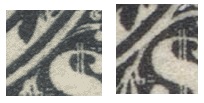
This one is quick and simple. All you need is a magnifying glass and some watermark fluid.
In 1890, the American Bank Note Company issued the “Baby Banknotes”, Scott #219-229. This series included Scott #229 which is an orange 90˘ issue showing Commodore Oliver Hazard Perry. In 1894, a few changes were made to this series of stamps; most notably the introduction of the triangles in the upper right and upper left corners of the stamp designs. One other change was that Commodore Perry moved from the 90˘ stamp to the $1 stamp. The color changed too – from orange to black.
This $1 stamp from the 1894 series has four different Scott catalog numbers: 261, 261A, 276, and 276A. Identification is very easy.
Scott #261 and #261A are not watermarked. Scott #276 and 276A are double line watermarked. Double line watermarks are large and more pronounced. It should be very easy to determine if a stamp is watermarked or not.
Now you need a 5x or stronger magnifying glass (unless your eyes are much sharper than mine). Scott #261 and #276 are Type I. Scott #261A and #276A are Type II. The difference is in the appearance of the white circle around the $1 denomination. In Type I, the circle is not continuous. It is broken by the frame line that surrounds the bust of Perry. In Type II, the circle is continuous.
It’s interesting to note that all of these stamps were produced by one printing plate. Starting from the left side of the printing plate, the first 15 columns of stamps are Type I. The last 5 columns of stamps are Type II. In general, 75% of these stamps are Type I and only 25% of these stamps are Type II. That is reflected in the catalog values too.
Shown here are two images of the right side $1 denomination. The left image is Type I (broken). The right image is Type II (continuous).
| Scott # | Watermark | Type |
| 261 | Unwatermarked | I |
| 261A | Unwatermarked | II |
| 276 | Double Line | I |
| 276A | Double Line | II |
